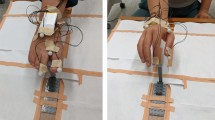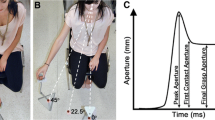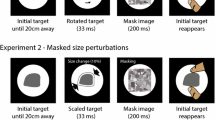Abstract
In order to recover balance by grasping an object for support, the CNS must rapidly move the hand toward a specific target (handhold) in the environment. The early latency (80–140 ms) of these grasping reactions would seem to preclude a role for online visual feedback in the control of the initial limb movement; however, some studies have shown that vision can influence initiation of lower-limb postural reactions at similar latency. This study explored the role of vision in controlling the initial trajectory of grasping reactions triggered by sudden unpredictable medio-lateral platform translation. Healthy young adults were instructed to recover balance by grasping a marked section of a handrail, located to their right. To reinforce a dependence on arm reactions, movement of the feet was prevented by barriers. Liquid-crystal goggles were used to occlude vision during response initiation (200 ms interval starting at perturbation onset, PO). Results showed that the initial grasping trajectory (first 100 ms) and associated muscle activation were heavily modulated to take into account the direction and speed of the perturbation-induced body motion in relation to the handrail. This modulation was unaffected by occlusion of vision at PO, indicating that information about the rail location obtained prior to PO was incorporated into the control. These findings are consistent with the view that the CNS tunes the initial arm trajectory by combining an egocentric spatial map, formed prior to PO, with online feedback about the body motion from non-visual inputs (somatosensory and/or vestibular). This prevents potential delays associated with visual processing and ensures very rapid onset of arm movement that is directed appropriately even though the position of the body is perturbed unpredictably with respect to the target.


Similar content being viewed by others
References
Abrams RA (1992) Coordination of eye and hand for aimed limb movements. In: Proteau L, Elliot D (eds) Vision and motor control. Elsevier, Amsterdam, pp 129–152
Bateni H, Zecevic A, McIlroy WE, Maki BE (2004) Resolving conflicts in task demands during balance recovery: does holding an object inhibit compensatory grasping? Exp Brain Res (in press)
Britton TC, Day BL, Brown P, Rothwell JC, Thompson PD, Marsden CD (1993) Postural electromyographic responses in the arm and leg following galvanic vestibular stimulation in man. Exp Brain Res 94:143–151
Colby CL (1998) Action-oriented spatial reference frames in cortex. Neuron 20:15–24
Day BI, Marsden CD (1982) Two strategies for learning a visually guided motor task. Percept Motor Skills 55:1003–1016
Desmurget M, Pelisson D, Rossetti Y, Prablanc C (1998) From eye to hand: planning goal-directed movements. Neurosci Biobehav Rev 22:761–788
Diener HC, Dichgans J, Guschlbauer B, Bacher M (1986) Role of visual and static vestibular influences on dynamic postural control. Hum Neurobiol 5:105–113
Flanders M, Daghestani L, Berthoz A (1999) Reaching beyond reach. Exp Brain Res 126:19–30
Georgopoulos AP (1988) On reaching. Ann Rev Neurosci 9:147–170
Ghafouri M, Archambault PS, Adamovich SV, Feldman AG (2002) Pointing movements may be produced in different frames of reference depending on the task demand. Brain Res 929:117–128
Hsiao ET, Robinovitch SN (1998) Common protective movements govern unexpected falls from standing height. J Biomech 31:1–9
Jeannerod M (1988) The neural and behavioural organization of goal-directed movements. Clarendon, Oxford
Lestienne F, Soechting J, Berthoz A (1977) Postural readjustments induced by linear motion of visual scenes. Exp Brain Res 28:363–384
Maki BE, McIlroy WE (1997) The role of limb movements in maintaining upright stance: the “change-in-support” strategy. Phys Ther 77:488–507
Maki BE, Ostrovski G (1993) Scaling of responses to transient and continuous postural perturbations. Gait Posture 1:93–104
Maki BE, McIlroy WE, Perry SD (1996) Influence of lateral destabilization on compensatory stepping responses. J Biomech 29:343–353
Maki BE, Perry SD, McIlroy WE (1998) Efficacy of handrails in preventing stairway falls: a new experimental approach. Safety Sci 28:189–206
Mars F, Archambault PS, Feldman AG (2003) Vestibular contribution to combined arm and trunk motion. Exp Brain Res 150:515–519
McIlroy WE, Maki BE (1994) Compensatory arm movements evoked by transient perturbations of upright stance. In: Taguchi K, Igarashi M, Mori S (eds) Vestibular and neural front. Elsevier, Amsterdam, pp 489–492
McIlroy WE, Maki BE (1995) Early activation of arm muscles follows external perturbations of upright stance. Neurosci Lett 184:177–180
Medendorp WP, Van Asselt S, Gielen CC (1999) Pointing to remembered visual targets after active one-step self-displacements within reaching space. Exp Brain Res 125:50–60
Meyer DE, Abrams RA, Kornblum S, Wright CE, Smith JEK (1988) Optimality in human motor performance: ideal control of rapid aimed movements. Psychol Rev 95:340–370
Nashner LM, Berthoz A (1978) Visual contribution to rapid motor responses during postural control. Brain Res 150:403–407
Pigeon P, Bortolami SB, DiZio P, Lackner JR (2003) Coordinated turn-and-reach movements. I. Anticipatory compensation for self-generated coriolis and interaction torques. J Neurophysiol 89:276–289
Runge CF, Shupert CL, Horak FB, Zajac FE (1998) Role of vestibular information in initiation of rapid postural responses. Exp Brain Res 122:403–412
Sparks DL (1989) The neural encoding of the location of targets for saccadic eye movements. J Exp Biol 146:195–207
Wang J, Stelmach GE (1998) Coordination among the body segments during reach-to-grasp action involving the trunk. Exp Brain Res 123:346–350
Acknowledgements
This work was supported by team and operating grants from the Canadian Institutes of Health Research (CIHR). BEM is a CIHR Senior Investigator and WEM holds a Canada Research Chair in Neurorehabilitation. The authors thank and acknowledge Yin-Yin Chung for her contributions to the collection and processing of the data.
Author information
Authors and Affiliations
Corresponding author
Additional information
The work was performed at the Centre for Studies in Aging, Sunnybrook and Women’s College Health Sciences Centre, 2075 Bayview Avenue, Toronto, Canada M4N 3M5
Rights and permissions
About this article
Cite this article
Ghafouri, M., McIlroy, W.E. & Maki, B.E. Initiation of rapid reach-and-grasp balance reactions: is a pre-formed visuospatial map used in controlling the initial arm trajectory?. Exp Brain Res 155, 532–536 (2004). https://doi.org/10.1007/s00221-004-1855-8
Received:
Accepted:
Published:
Issue Date:
DOI: https://doi.org/10.1007/s00221-004-1855-8




